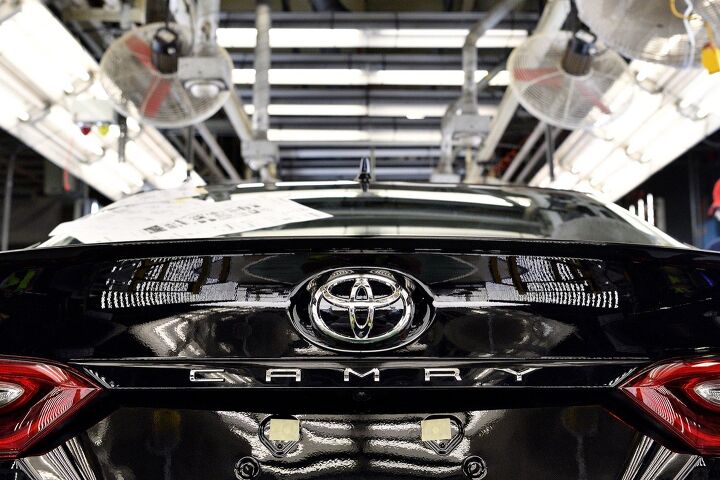All of the New 2018 Toyota Camrys Sold in America in July Were Japan Imports
We learned early in July that many of the early 2018 Toyota Camrys available in Toyota’s U.S. showrooms wouldn’t be built in Toyota’s Georgetown, Kentucky, assembly plant.
Through June, not a single one of the 2016 and 2017 Camrys sold in America were imported. But all of the 2018 Toyota Camrys sold in July came across the Pacific from Japan.
Granted, most of the Camrys leaving Toyota showrooms are still old new Camrys, not new new Camrys.
The reason for Kentucky’s delay? Transitioning to an assembly line that runs the Toyota New Global Architecture requires “a couple steps back before it can move forward in efficiency.” Despite added workforce — Georgetown has more employees now than ever before — ramping up production in Kentucky was never intended to be an instantaneous action.
So after noticing in Toyota’s monthly sales report that Toyota sold 33,827 total Camrys but only 31,230 North American-built Camrys, we wanted to know where the 2017/2018 line was drawn.
“All 2018 Camry’s sold in July were imported from Japan,” Toyota spokesperson Sam Butto tells TTAC.
Without those new Japanese imports, the Toyota Camry was still America’s best-selling midsize car in July. (The Honda Civic was America’s top-selling car overall last month.) But rather than a modest 1-percent downturn, Camry volume would have fallen 9 percent. Instead, the first 2,587 copies of the all-new 2018 Toyota Camry accounted for 8 percent of the Camrys sold in the United States in July.
In total, the Toyota/Lexus family has relied upon non-NAFTA vehicles for 28 percent of the 1,377,222 U.S. auto sales the company’s generated in the first seven months of 2017. Toyota does, however, build more Camrys in the U.S. than any other vehicle.
Through the end of July, the Camry trails the Honda Civic by 1,722 sales in the Toyota’s quest to end 2017 as America’s top-selling car for a 16th consecutive year. Of the 212,446 Civics sold so far in 2017, 44,737 have been England-built hatchbacks.
Meanwhile, Toyota’s Butto says, “As soon as our Kentucky plant finishes ramping up for the 2018 model, all 2018 Camry’s will be manufactured here for the U.S. market.”
[Image: Toyota]
Timothy Cain is a contributing analyst at The Truth About Cars and Autofocus.ca and the founder and former editor of GoodCarBadCar.net. Follow on Twitter @timcaincars.
More by Timothy Cain
Latest Car Reviews
Read moreLatest Product Reviews
Read moreRecent Comments
- Amy I owned this exact car from 16 until 19 (1990 to 1993) I miss this car immensely and am on the search to own it again, although it looks like my search may be in vane. It was affectionatly dubbed, " The Dragon Wagon," and hauled many a teenager around the city of Charlotte, NC. For me, it was dependable and trustworthy. I was able to do much of the maintenance myself until I was struck by lightning and a month later the battery exploded. My parents did have the entire electrical system redone and he was back to new. I hope to find one in the near future and make it my every day driver. I'm a dreamer.
- Jeff Overall I prefer the 59 GM cars to the 58s because of less chrome but I have a new appreciation of the 58 Cadillac Eldorados after reading this series. I use to not like the 58 Eldorados but I now don't mind them. Overall I prefer the 55-57s GMs over most of the 58-60s GMs. For the most part I like the 61 GMs. Chryslers I like the 57 and 58s. Fords I liked the 55 thru 57s but the 58s and 59s not as much with the exception of Mercury which I for the most part like all those. As the 60s progressed the tail fins started to go away and the amount of chrome was reduced. More understated.
- Theflyersfan Nissan could have the best auto lineup of any carmaker (they don't), but until they improve one major issue, the best cars out there won't matter. That is the dealership experience. Year after year in multiple customer service surveys from groups like JD Power and CR, Nissan frequency scrapes the bottom. Personally, I really like the never seen new Z, but after having several truly awful Nissan dealer experiences, my shadow will never darken a Nissan showroom. I'm painting with broad strokes here, but maybe it is so ingrained in their culture to try to take advantage of people who might not be savvy enough in the buying experience that they by default treat everyone like idiots and saps. All of this has to be frustrating to Nissan HQ as they are improving their lineup but their dealers drag them down.
- SPPPP I am actually a pretty big Alfa fan ... and that is why I hate this car.
- SCE to AUX They're spending billions on this venture, so I hope so.Investing during a lull in the EV market seems like a smart move - "buy low, sell high" and all that.Key for Honda will be achieving high efficiency in its EVs, something not everybody can do.



































Comments
Join the conversation
gimme a J vin any time. as for the orange peel? seems to me the germans are wurst at it.
I'll be! The US isn't competitive in the auto business! Australia Camry production moved to Japan as well. This is a good idea by Toyota. The consumer will get a better and cheaper product.